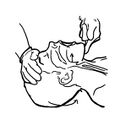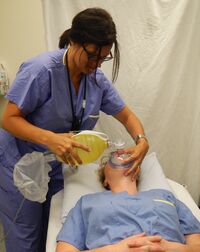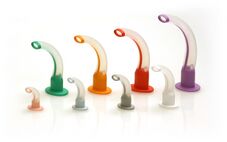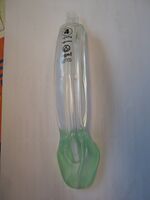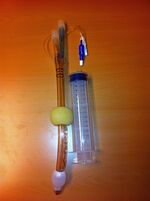Securing the airway
The topic is also covered in the summary article Securing the airways (half heels)
This article describes actions leading to ensure potency of the patient's airways . Securing the airway has several goals, fulfilled to varying degrees by individual methods:
- removing the obstruction and preventing its recurrence;
- allowing for adequate ventilation;
- enabling suction of retained secretions, especially during long-term maintenance of DC;
- protection against aspiration, especially of gastric juices.
Anatomy[edit | edit source]
- Upper respiratory tract – nasal cavities, nasopharynx, larynx.
- Lower respiratory tract – trachea, bronchi (main, lobar, segmental), bronchioles, ductus alveolaris, alveoli.
Non-invasive techniques[edit | edit source]
Basic methods of non-invasive airway potency include various maneuvers and techniques with aids , especially face mask ventilation .
This category also includes some specific methods, especially the nasal mask used in the therapy of sleep apnea syndrome .
![]() During first aid, it is necessary to review the contents of the oral cavity in an unconscious patient and remove any obstruction! This can be, for example, a foreign body, vomit or blood after an injury. Before starting attempts to resuscitate breathing and circulation, it is advisable to remove this, for example by suctioning or turning it on its side for a short time.
During first aid, it is necessary to review the contents of the oral cavity in an unconscious patient and remove any obstruction! This can be, for example, a foreign body, vomit or blood after an injury. Before starting attempts to resuscitate breathing and circulation, it is advisable to remove this, for example by suctioning or turning it on its side for a short time.
Maneuvers[edit | edit source]
These techniques are mainly used in first aid and serve to relieve the upper respiratory tract.
- Double maneuver (with the hand on the forehead we make a bend, the fingers of the other hand raise the chin).
- Simple to implement, also recommended as part of lay first aid.
- Eliminates obstruction by the root of the tongue as the most common cause of loss of consciousness.
- Jaw thrust - a maneuver performed when a cervical spine injury is suspected
- We open the mouth and move the lower jaw forward beyond the angle of the mandible without tilting the head.
- However, the need to open the airway is superior to the risk of spinal cord injury if bending over is necessary.
- Triple maneuver (tilting the head, opening the mouth, pushing the mandible up and forward).
- Also the SAFAR maneuver, a combination of head tilt and jaw thrust.
- It requires both hands and is more complicated than the double maneuver, but it is more effective.
- Stabilized position
- Side position with bent knee to prevent overturning, preventing aspiration at risk of vomiting.
- It is not directly a position that makes the airways passable, but prevents their obstruction.
- Currently, it is only recommended for patients from whom I have to leave during the provision of first aid (mass accident, call to the RZP, …)
- Heimlich maneuver - pressure on the epigastrium.
- Gordon's maneuver - a blow between the shoulder blades.
Face mask breathing[edit | edit source]
A prerequisite for successful ventilation with aids is a free airway (removal of any loose objects from the oral cavity), in emergency situations it is sometimes necessary to suction secretions from the oral cavity. Breathing with a face mask is the basis of successful first aid and airway clearance in the operating room . Some simple short operations can be performed under general anesthesia only using mask ventilation (short gynecological procedures, perianal abscess operations, …)
To use a face mask you need:
- choose the appropriate mask size;
- make sure the mask is properly placed on the patient's face – the nose and mouth must be perfectly covered by the mask so that air does not escape outside the patient's airways (often difficult, especially for people with dentures removed);
- for fixation, we use the so-called C touch – the thumb and forefinger embrace the mask and press it to the face, the other three fingers embrace the lower jaw up to its angle, beyond which they push it forward and press it against the mask;
- the other hand usually ventilates with a self-expanding bag ( AmbuVak ), in case of difficulties we can use both hands to press the mask perfectly and luxate the jaw, the second person or the device ventilates;
- the position of the head is important, the so-called sniffing position (anteflexion of the cervical spine, reclination in the atlanto-occipital joint – moving the head forward, as if I were sniffing at a flower);
- if optimal ventilation of the patient cannot be achieved even with optimal head position, selection of the correct size and position of the mask, we can help with invasive devices (Guedel or Wendel tube, see below).
Face mask ventilation can also be used in children's anesthesia for the administration of inhalation anesthesia during induction of anesthesia (it is less traumatic for children than venipuncture).
Problems with successful breathing can be expected in obese patients, patients with missing teeth or facial deformities. During mask ventilation, it is necessary to observe the occurrence of obstruction , for example by aspiration or laryngospasm, manifested by retracting the jugular, sounds during breathing or inspiratory stridor.
Invasive techniques[edit | edit source]
It serves to open and maintain the patency of the airways using special devices that cross the immunological barriers of the airways (anatomical integrity, lymphatic tissue of the nasal and oral cavity).
- Oral ( Guedel ) and nasal (Wendel) airways;
- we introduce in unconsciousness or anesthesia - when conscious, they can trigger a gag reflex,
- they enable the passage of airways at the root of the tongue, they are often used together with maneuvers (jaw thrust in the picture above) and mask ventilation,
- oral airways are more often used, nasal airways can be successfully used in patients who are partially conscious and have, for example, spontaneous ventilation with HCD obstruction, it is better tolerated.
- Extratracheal:
- Supraglottic devices – laryngeal mask,
- combi tube ,
- pharyngotracheal airways (various versions of the airways mentioned above, with a balloon, differently anatomically located),
- coniopuncture .
- Endotracheal:
- endotracheal intubation,
- tracheostomy .
Laryngeal mask[edit | edit source]
Differently designed aids, which are introduced supraglottic, can be used both in elective airway management for minor procedures, and for emergency airway management during CPR by non-medical personnel, or during difficult intubation. In some models, fixation is done by inflating the sealing cuff, in others ( i-gel ) inflation is not necessary due to the anatomical shaping.
- Advantages:
- simple installation method,
- no need for muscle relaxation,
- less risk of damage to the vocal cords,
- the entire procedure is faster than endotracheal intubation,
- newer types also allow endotracheal intubation through the lumen, bronchoscopy or insertion of a nasogastric tube.
- Disadvantages:
- pharyngeal and laryngeal reflexes with insufficient depth of anesthesia,
- higher risk of aspiration of gastric contents than with tracheal intubation (but less than with mask ventilation),
- the risk of damage to the epiglottis in case of incorrect insertion and to the nerves due to the pressure of an inflated laryngeal mask (N. lingualis, N. laryngeus recurrentens , N. hypoglossus ).
- Contraindication
- the patient is not hungry or there is a risk of aspiration,
- low pulmonary compliance and high pulmonary resistance,
- cardiac insufficiency or hiatal hernia ,
- adiposity (extreme weight),
- airway obstruction,
- procedures in which the airway must be reliably secured (apart from long major procedures or procedures on the lungs, all laparoscopic procedures - increase the risk of aspiration and it is necessary to maintain sufficient pressures in the lungs).
Combi tube[edit | edit source]
The combitube is a blindly inserted tube with obturation cuffs designed for pre-hospital care, which enables ventilation when inserted both into the esophagus and into the trachea. Today it is almost no longer used , it has been replaced in most indications by the use of a laryngeal mask.
More detailed information can be found on the Kombitubus/SŠ (nurse) page . Iron
Endotracheal intubation[edit | edit source]
Endotracheal intubation is the "gold standard" for securing the airway. This is invasive securing of the airways with the help of an endotracheal tube, inserted through the mouth or nose.
More detailed information can be found on the page Endotracheal intubation . Iron
Crush introduction to anesthesia (Rapid sequence induction)[edit | edit source]
RSI is used when there is a high risk of aspiration (fasting patient, ileus , etc.). These are recommended differences in the introduction to anesthesia, for example the use of fast-acting muscle relaxants or not breathing through a face mask.
For more detailed information, see Crush's Introduction to Anesthesia page . Iron
Difficult intubation[edit | edit source]
- A condition where we need more than three attempts for routine laryngoscopy and intubation or it takes more than 10 minutes.
- Difficult laryngoscopy during intubation is particularly difficult:
- In pregnant women, with hyperplasia of the thyroid gland, with epiglottitis, limited mobility of the cervical spine, small oral cavity, burn conditions, …
- Grading of difficulty using the Cormack and Lehane score .
See Difficult intubation page for more detailed information . Iron
Tracheostomy[edit | edit source]
Insertion of an intubation tube through a surgically created opening into the trachea to provide ventilation. Unlike coniotomy, this is not a purely acute procedure and can be long-term.
See the Tracheostomy page for more detailed information . Iron
Cricothyrotomy, Coniotomy[edit | edit source]
Acute procedure to secure the airway. Creation of communication with the trachea in the area of the ligaments. cricothyroideum to provide ventilation.
For more detailed information, see the Coniotomy page . Iron
Video library[edit | edit source]
History[edit | edit source]
- Circa 3000 BC – Bible Old Testament - artificial respiration for asphyxiating newborns - "The midwife Puah put her mouth to the child's mouth and it cried."
- 1275 BC – Battle of Kadesh - Bimanual jaw thrust.
- 960 AD – Avicenna - describes a method similar to endotracheal intubation in the Canon of Medicine. – "If necessary, insert a silver tube through the throat to support breathing".
- 1732 – Scottish surgeon Tossach - mouth-to-mouth breathing.
- 1794 – John Herhold and Carl Rasn - mouth-to-mouth breathing, consideration of the use of a tracheal tube.
- 1900 – Franz Kuhn - intubation using an "autoscope".
- Chevalier Jackson - improvement of autoscope and renaming to laryngoscope.
- J. W. Magil and Robert R. Macintosh further improvements in the laryngoscope and endotracheal intubation technique .
- 1956 – Peter Safar - mouth-to-mouth breathing, head tilt and nose closure (Triple Touch) in first aid and resuscitation.
- 1983 – Archie Brain - Laryngeal Mask.
Links[edit | edit source]
Related Articles[edit | edit source]
- Securing the airways - a clear page, the advantages and disadvantages of individual approaches in brief
External links[edit | edit source]
- Brtníková Věra, Sedlák Ctirad – Techniques for securing airways KAR FN Olomouc
- Jan Bruthans – Airway protection KARIM 1.LF UK
- Akutne.cz: Possibilities of ensuring airway patency by general practitioners
References[edit | edit source]
- KRETZ, Franz-Josef – TEUFEL, Frank. Anästhesie und Intensivmedizin. 1. edition. Heidelberg : Springer, 2006. pp. 695. ISBN 3-540-62739-1.
- HECK, Michael – FRESENIUS, Michael. Repetitorium Anästhesiologie. 5. edition. Heidelberg : Springer, 2007. 642 pp. ISBN 978-3-540-46575-1.

